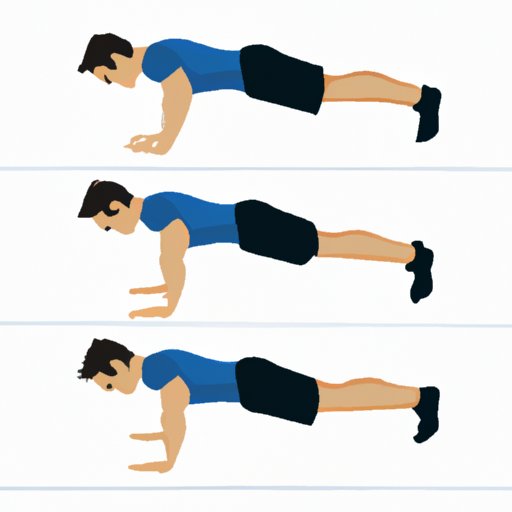
I. Introduction
Push-ups are one of the most effective exercises for strengthening your upper body, lower body, and core muscles. They are a great exercise for all fitness levels and can be done anytime, anywhere. This article will provide a detailed step-by-step guide on how to do a push-up, variations of push-ups, a push-up challenge, benefits of push-ups, common mistakes to avoid, and push-ups for different fitness levels.
II. Step-by-step guide on how to do a push-up
The first step in doing a push-up is to have the proper form. Start in a plank position, with your shoulders stacked over your wrists. Your body should form a straight line from head to heels. Engage your core and squeeze your glutes. Ideally, your feet should be hip-width apart (but you can have them wider or narrower if that feels more comfortable).
Next, lower yourself down toward the ground while keeping your elbows close to your sides. Lower until your chest touches the ground or your arms reach a 90-degree angle. Push back up, exhaling on the way up, bringing your body back to the starting position. Repeat for the desired number of repetitions.
It’s important to engage the proper muscles while performing a push-up. Make sure to keep your shoulders away from your ears, retract your shoulder blades, and engage your chest, triceps, and core muscles. Remember to keep your head in a neutral position by looking at the ground about a foot in front of your hands.
For a visual guide, check out this instructional video:
III. Variations of push-ups
There are several types of push-ups that you can do to modify the exercise and work different muscle groups. The incline push-up is less challenging and is perfect for beginners. Place your hands on a bench, step, or wall, and perform a push-up. The higher the surface, the easier the push-up will be.
The decline push-up is more challenging and involves placing your feet on an elevated surface such as a bench or step while doing a push-up. This variation works the upper chest, shoulders, and triceps.
The diamond push-up is a great variation for targeting the triceps muscles. Begin in a high plank position with your hands close together, forming a diamond shape with your fingers. Lower your body down toward the ground, keeping your elbows close to your sides. Push back up to the starting position.
Make sure to choose the variation of push-up that is appropriate for your fitness level and goals. For a more detailed guide, check out this video:
IV. Push-up challenge
A push-up challenge is a great way to add some variety to your workout and improve your fitness level. Set a specific number of push-ups to do each day for a certain period of time. Start with a number that is challenging, but still attainable for you. As you progress through the challenge, increase the number of push-ups or make the push-ups more challenging.
Motivation is key to completing a push-up challenge. Find an accountability partner, create a visual reminder, and set a reward for finishing the challenge. Remember, the benefits of the challenge are both physical and mental. You will increase your strength and endurance while also building confidence and discipline.
V. Benefits of push-ups
Push-ups provide numerous benefits for your body and mind. They increase upper-body strength and endurance, helping to build chest, shoulder, arm, and core muscles. Regularly performing push-ups can also improve posture, increase bone density, and reduce the risk of injury.
Don’t just take our word for it. Hear from people who have seen results from doing push-ups regularly:
“I do push-ups every day, and my posture has improved significantly. My back pain has decreased, and my core strength has improved.” – Jane
“Incorporating push-ups into my daily routine has helped me feel stronger and more confident in my body. I love how I can easily do them at home without any equipment.” – Mike
VI. Common mistakes to avoid
While push-ups are a fantastic exercise, there are some common mistakes that people make. Flaring the elbows, sagging the hips, and letting the head drop are all common mistakes that can lead to injury or poor form. To avoid these mistakes, keep your elbows close to your sides and engage your abdominal muscles to keep your hips in line with the rest of your body. Keep your head in a neutral position by looking at the ground about a foot in front of your hands.
VII. Push-ups for different fitness levels
No matter your fitness level, push-ups can be modified to work for you. For beginners, start with incline push-ups. Intermediate exercisers can try the traditional push-up with an emphasis on form. Advanced exercisers can try decline push-ups or diamond push-ups. Push-ups can be continually challenging by adding more repetitions, holding the bottom position for a few seconds, or adding a push-up variation.
Here are a few progressions for each level:
- Beginner: incline push-ups with hands on a high surface
- Intermediate: traditional push-ups with hands on the ground
- Advanced: decline push-ups with feet on a high surface
VIII. Conclusion
Push-ups are a timeless exercise that can be done anytime, anywhere. Use the step-by-step guide provided in this article to ensure proper form and prevent injury. Incorporate variations and challenges to continually challenge yourself and work different muscle groups. Don’t forget the benefits of push-ups, which include improved strength, endurance, posture, and bone density.




